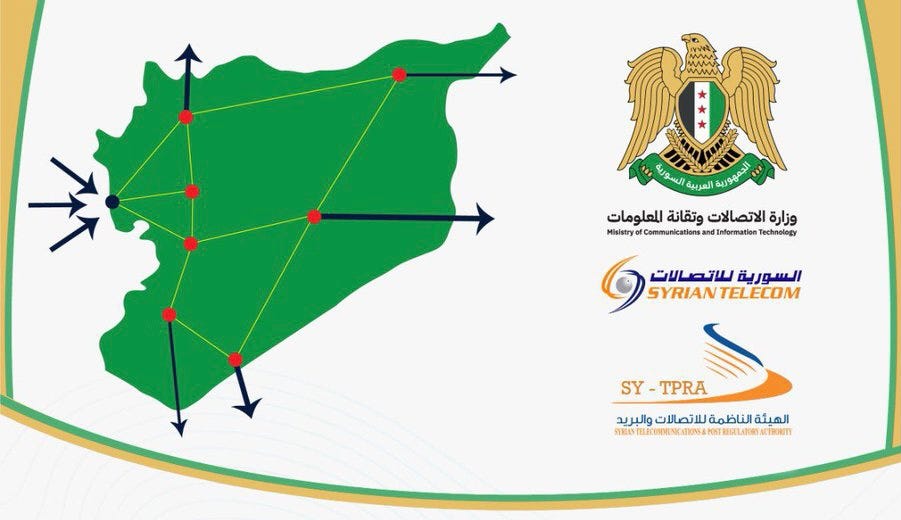SilkLink Launch Turns Syria’s Digital Hub Vision into Reality
Establishing a Syrian stop on the digital Silk Road may create opportunities for its integration in the IMEC.
On 13 May, the Syrian Ministry of Communications and Information Technology launched ‘Silklink’, a project to develop fibre optic infrastructure in the country. The announcement follows the Ministry’s recent launch of the country’s first pilot trial of a fifth-generation (5G), further accelerating Syria’s ambition to become a regional digital hub. Furthermore, this move coincides with US President Trump’s recent announcement of the complete lifting of sanctions on Damascus to give it “a chance at greatness”. It is likely to further catalyse France’s recent efforts to attract much-needed Western investment in the war-torn country, alongside others.
Another Building Block: Digital Infrastructure
The SilkLink project aims to deliver fibre optic infrastructure with a capacity of up to 100 terabits per second (Tbps), enabling high-speed, reliable internet connectivity. This initiative builds on recent strides in Syria’s digital and communications landscape, including the 5G trial, the Ugarit-2 project, and growing energy investments from Turkish and Qatari firms. According to the Syrian government, SilkLink seeks to transform the country into “a regional digital hub for data transmission and international communications”.
Spanning an estimated 4,500 kilometres, the fibre optic network will connect Damascus and Aleppo while linking to regional hubs in neighbouring countries. It also promises a new land-based corridor connecting Europe to Asia, offering an alternative to maritime routes. The Minister of Communications and Information Technology emphasised the project’s role in laying the foundation for advanced technologies, such as cloud computing and data centres, potentially attracting major global tech firms. Al-Sharaa’s government is currently seeking interested companies to partner with, as they aim to establish the project through public-private partnerships.
Ode to the Past, Glimpse of the Future?
The name SilkLink is derived from the historic Silk Road, which connects China in the Far East to West Asia and beyond. This symbolism is timely, following a recent meeting between Chinese investors and Syria’s Minister of Transport, where discussions centred on railway and cargo transport investments. Last month, Syria’s Foreign Minister also expressed a desire to forge a “strategic partnership” with China, signalling deeper bilateral ties. These developments suggest Beijing may play a significant role in Syria’s reconstruction and digital ambitions, potentially aligning with China’s Belt and Road Initiative.
From Vision to Reality
The SilkLink announcement marks a pivotal moment in Syria’s post-war reconstruction and may point to a prosperous, high-tech future as a regional trade hub. As such, it appears Al-Sharaa’s ambitious moves are no longer symbolic, as the recent 5G trial has been rendered, but are instead beginning to materialise. Nonetheless, significant challenges remain, and attracting investment will continue to prove difficult while sectarian violence persists. It is possible that increased investment—along with the accompanying conditions—may lead to the development of a more comprehensive and conducive strategy for minority rights, potentially helping to ease such tensions. However, that remains to be seen.
US President Trump’s recent call for the lifting of sanctions, though hopeful in tone, is unlikely to be supported by Congress, which has long been influenced by pro-Israel donors and backers. It is probable that any promised sanctions relief will require substantial concessions, such as the normalisation of Syria–Israel relations. Al-Sharaa has already expressed his willingness to take such a step.
The IMEC link
Syria’s SilkLink initiative could contribute significantly to the broader ambitions of the India-Middle East-Europe Economic Corridor by reinforcing the digital backbone that underpins modern trade, communication, and financial flows. While IMEC’s primary thrust is on transport logistics and energy infrastructure, it also includes an explicit focus on digital connectivity. By installing thousands of kilometres of optical fibre and establishing a submarine landing station in Tartus, SilkLink offers the potential to link IMEC’s southern and eastern routes through alternative terrestrial data corridors. This would increase the resilience of digital flows between the Gulf, the Levant, and Europe, particularly at a time when reliance on undersea cables remains a critical vulnerability for global internet traffic.
The integration of Syria into regional data networks through SilkLink could also enhance IMEC’s aim of fostering economic interdependence and connectivity among participating states. If Syria can re-establish stable infrastructure and maintain neutrality in data exchange, its geography makes it a natural bridge between Iraq, Jordan, Lebanon, and Turkey. These are countries whose infrastructure is already being linked to either IMEC’s transport plans or to regional data initiatives. By enabling high-speed fibre transit and linking with projects like Ugarit 2, Syria has the capacity to act as a secondary digital corridor that complements the physical trade routes of IMEC. In this way, even without formal participation in the corridor, Syria could still serve a crucial infrastructural function within its wider ecosystem.





